Land Surface Temperature Changes in Different Urbanization Increments in China since 2000
Abstract
:1. Introduction
2. Materials and Methods
2.1. Study Area
2.2. Data and Data Preprocessing
2.3. Methodology
2.3.1. Delineation of the Spatial Units for Analysis
2.3.2. Quantification of the Urban Heat Island Intensity (UHII)
2.3.3. Quantification of the LST Dynamic Trend
3. Results
3.1. Basic Characteristics of the LST Dynamic in China
3.2. Interannual UHII at National Scale
3.3. LST Dynamic across Cities in China
3.4. City-Scale UHII Related to Urban Growth Speed
3.5. City-Scale UHII Related to Urban Expansion Percentage
4. Discussion
4.1. Comparisons of This Work to Other Existing Studies
4.2. LST Dynamic Related to Urban Growth in China
4.3. Limitations and Outlook
5. Conclusions
Author Contributions
Funding
Data Availability Statement
Acknowledgments
Conflicts of Interest
References
- Angel, S.; Parent, J.; Civco, D.L.; Blei, A.; Potere, D. The dimensions of global urban expansion: Estimates and projections for all countries, 2000–2050. Prog. Plan. 2011, 75, 53–107. [Google Scholar] [CrossRef]
- Taubenboeck, H.; Droin, A.; Standfuss, I.; Dosch, F.; Sander, N.; Milbert, A.; Eichfuss, S.; Wurm, M. To be, or not to be ‘urban‘? A multi-modal method for the differentiated measurement of the degree of urbanization. Comput. Environ. Urban Syst. 2022, 95, 101830. [Google Scholar] [CrossRef]
- He, B.-J.; Wang, J.; Zhu, J.; Qi, J. Beating the urban heat: Situation, background, impacts and the way forward in China. Renew. Sustain. Energy Rev. 2022, 161, 112350. [Google Scholar] [CrossRef]
- Angelil, O.; Stone, D.; Wehner, M.; Paciorek, C.J.; Krishnan, H.; Collins, W. An Independent Assessment of Anthropogenic Attribution Statements for Recent Extreme Temperature and Rainfall Events. J. Clim. 2017, 30, 5–16. [Google Scholar] [CrossRef]
- Cheng, X.; Lan, T.; Mao, R.; Gong, D.-Y.; Han, H.; Liu, X. Reducing air pollution increases the local diurnal temperature range: A case study of Lanzhou, China. Meteorol. Appl. 2020, 27, e1939. [Google Scholar] [CrossRef]
- Hallegatte, S.; Green, C.; Nicholls, R.J.; Corfee-Morlot, J. Future flood losses in major coastal cities. Nat. Clim. Chang. 2013, 3, 802–806. [Google Scholar] [CrossRef]
- Murray, V.; Ebi, K.L. IPCC Special Report on Managing the Risks of Extreme Events and Disasters to Advance Climate Change Adaptation (SREX). J. Epidemiol. Community Health 2012, 66, 759–760. [Google Scholar] [CrossRef]
- Nguyen, O.V.; Kawamura, K.; Trong, D.P.; Gong, Z.; Suwandana, E. Temporal change and its spatial variety on land surface temperature and land use changes in the Red River Delta, Vietnam, using MODIS time-series imagery. Environ. Monit. Assess. 2015, 187, 11. [Google Scholar] [CrossRef]
- Westermann, S.; Langer, M.; Boike, J. Systematic bias of average winter-time land surface temperatures inferred from MODIS at a site on Svalbard, Norway. Remote Sens. Environ. 2012, 118, 162–167. [Google Scholar] [CrossRef]
- Khan, R.; Li, H.; Basir, M.; Chen, Y.L.; Sajjad, M.M.; Ul Haq, I.; Ullah, B.; Arif, M.; Hassan, W. Monitoring land use land cover changes and its impacts on land surface temperature over Mardan and Charsadda Districts, Khyber Pakhtunkhwa (KP), Pakistan. Environ. Monit. Assess. 2022, 194, 409. [Google Scholar] [CrossRef]
- Liu, Y.; Huang, X.; Yang, Q.Q.; Cao, Y.X. The turning point between urban vegetation and artificial surfaces for their competitive effect on land surface temperature. J. Clean Prod. 2021, 292, 11. [Google Scholar] [CrossRef]
- Li, H.; Meier, F.; Lee, X.; Chakraborty, T.; Liu, J.; Schaap, M.; Sodoudi, S. Interaction between urban heat island and urban pollution island during summer in Berlin. Sci. Total Environ. 2018, 636, 818–828. [Google Scholar] [CrossRef] [PubMed]
- Yin, Z.; Liu, Z.; Liu, X.; Zheng, W.; Yin, L. Urban heat islands and their effects on thermal comfort in the US: New York and New Jersey. Ecol. Indic. 2023, 154, 110765. [Google Scholar] [CrossRef]
- Li, X.; Stringer, L.C.; Chapman, S.; Dallimer, M. How urbanisation alters the intensity of the urban heat island in a tropical African city. PLoS ONE 2021, 16, e0254371. [Google Scholar] [CrossRef]
- Wemegah, C.S.; Yamba, E.I.; Aryee, J.N.A.; Sam, F.; Amekudzi, L.K. Assessment of urban heat island warming in the greater accra region. Sci. Afr. 2020, 8, e00426. [Google Scholar] [CrossRef]
- Qiao, Z.; Wang, N.; Chen, J.; He, T.; Xu, X.; Liu, L.; Sun, Z.; Han, D. Urbanization accelerates urban warming by changing wind speed: Evidence from China based on 2421 meteorological stations from 1978 to 2017. Environ. Impact Assess. Rev. 2023, 102, 107189. [Google Scholar] [CrossRef]
- Ward, K.; Lauf, S.; Kleinschmit, B.; Endlicher, W. Heat waves and urban heat islands in Europe: A review of relevant drivers. Sci. Total Environ. 2016, 569–570, 527–539. [Google Scholar] [CrossRef] [PubMed]
- Shen, P.; Zhao, S.; Ma, Y.; Liu, S. Urbanization-induced Earth’s surface energy alteration and warming: A global spatiotemporal analysis. Remote Sens. Environ. 2023, 284, 113361. [Google Scholar] [CrossRef]
- Mohajerani, A.; Bakaric, J.; Jeffrey-Bailey, T. The urban heat island effect, its causes, and mitigation, with reference to the thermal properties of asphalt concrete. J. Environ. Manag. 2017, 197, 522–538. [Google Scholar] [CrossRef]
- Wang, R.C.; Murayama, Y. Geo-simulation of land use/cover scenarios and impacts on land surface temperature in Sapporo, Japan. Sustain. Cities Soc. 2020, 63, 11. [Google Scholar] [CrossRef]
- Chen, H.; Huang, J.J.; Li, H.; Wei, Y.; Zhu, X. Revealing the response of urban heat island effect to water body evaporation from main urban and suburb areas. J. Hydrol. 2023, 623, 129687. [Google Scholar] [CrossRef]
- Yang, B.; Yang, X.; Leung, L.R.; Zhong, S.; Qian, Y.; Zhao, C.; Chen, F.; Zhang, Y.; Qi, J. Modeling the Impacts of Urbanization on Summer Thermal Comfort: The Role of Urban Land Use and Anthropogenic Heat. J. Geophys. Res. Atmos. 2019, 124, 6681–6697. [Google Scholar] [CrossRef]
- Yao, L.; Sun, S.; Song, C.; Wang, Y.; Xu, Y. Recognizing surface urban heat ‘island’ effect and its urbanization association in terms of intensity, footprint, and capacity: A case study with multi-dimensional analysis in Northern China. J. Clean Prod. 2022, 372, 133720. [Google Scholar] [CrossRef]
- Zhou, D.; Bonafoni, S.; Zhang, L.; Wang, R. Remote sensing of the urban heat island effect in a highly populated urban agglomeration area in East China. Sci. Total Environ. 2018, 628–629, 415–429. [Google Scholar] [CrossRef] [PubMed]
- Zhou, D.C.; Zhao, S.Q.; Liu, S.G.; Zhang, L.X.; Zhu, C. Surface urban heat island in China’s 32 major cities: Spatial patterns and drivers. Remote Sens. Environ. 2014, 152, 51–61. [Google Scholar] [CrossRef]
- Ge, J.; Wang, H.; He, S. Seasonal-Spatial Distribution and Driving Forces of Land Surface Temperature in the Urban Development Area of Wuhan. Resour. Environ. Yangtze Basin 2021, 30, 351–360. [Google Scholar]
- He, B.; Zhao, W.; Li, A.; Feng, W.; Tan, J.; Lei, G.; Nan, X. Comparative Study on Thermal Environment between Old Urban Areas and New Urban Areas based on Landsat 8Remote Sensing Image: A Case Study of Chengdu City. Remote Sens. Technol. Appl. 2017, 32, 1141–1150. [Google Scholar]
- Sun, Z.; Du, W.; Jiang, H.; Weng, Q.; Guo, H.; Han, Y.; Xing, Q.; Ma, Y. Global 10-m impervious surface area mapping: A big earth data based extraction and updating approach. Int. J. Appl. Earth Obs. Geoinf. 2022, 109, 102800. [Google Scholar] [CrossRef]
- Yu, S.; Tobias, L.; Zhang, Z.; Liu, F.; Wang, X.; Yan, X.; Hannes, T. Does urban growth mean the loss of greenness? A multi-temporal analysis for Chinese cities. Sci. Total Environ. 2023, 898, 166373. [Google Scholar] [CrossRef]
- Press, S. Administrative Division of the People’s Republic of China Handbook 2015, 1st ed.; SinoMaps Press: Beijing, China, 2015; p. 167. [Google Scholar]
- Wan, Z.M.; Li, Z.L. A physics-based algorithm for retrieving land-surface emissivity and temperature from EOS/MODIS data. IEEE Trans. Geosci. Remote Sens. 1997, 35, 980–996. [Google Scholar] [CrossRef]
- Zhang, Y.Z.; Jiang, X.G.; Wu, H. A Generalized Split-window Algorithm for Retrieving Land Surface Temperature from GF-5 Thermal Infrared Data. In Proceedings of the Progress in Electromagnetics Research Symposium—Spring (PIERS), St. Petersburg, Russia, 22–25 May 2017; pp. 2766–2771. [Google Scholar] [CrossRef]
- Meng, Q.; Zhang, L.; Sun, Z.; Meng, F.; Wang, L.; Sun, Y. Characterizing spatial and temporal trends of surface urban heat island effect in an urban main built-up area: A 12-year case study in Beijing, China. Remote Sens. Environ. 2018, 204, 826–837. [Google Scholar] [CrossRef]
- Yang, Q.; Huang, X.; Tang, Q. The footprint of urban heat island effect in 302 Chinese cities: Temporal trends and associated factors. Sci. Total Environ. 2019, 655, 652–662. [Google Scholar] [CrossRef]
- Zhang, Z.X.; Wang, X.; Zhao, X.L.; Liu, B.; Yi, L.; Zuo, L.J.; Wen, Q.K.; Liu, F.; Xu, J.Y.; Hu, S.G. A 2010 update of National Land Use/Cover Database of China at 1:100000 scale using medium spatial resolution satellite images. Remote Sens. Environ. 2014, 149, 142–154. [Google Scholar] [CrossRef]
- Imhoff, M.L.; Zhang, P.; Wolfe, R.E.; Bounoua, L. Remote sensing of the urban heat island effect across biomes in the continental USA. Remote Sens. Environ. 2010, 114, 504–513. [Google Scholar] [CrossRef]
- Thompson, J.A.; Paull, D.J. Assessing spatial and temporal patterns in land surface phenology for the Australian Alps (2000–2014). Remote Sens. Environ. 2017, 199, 1–13. [Google Scholar] [CrossRef]
- Fernandes, R.; Leblanc, S.G. Parametric (modified least squares) and non-parametric (Theil-Sen) linear regressions for predicting biophysical parameters in the presence of measurement errors. Remote Sens. Environ. 2005, 95, 303–316. [Google Scholar] [CrossRef]
- Planque, C.; Carrer, D.; Roujean, J.-L. Analysis of MODIS albedo changes over steady woody covers in France during the period of 2001–2013. Remote Sens. Environ. 2017, 191, 13–29. [Google Scholar] [CrossRef]
- Mu, X.; Fang, C.; Yang, Z. Spatio-temporal evolution and dynamic simulation of the urban resilience of Beijing-Tianjin-Hebei urban agglomeration. J. Geogr. Sci. 2022, 32, 1766–1790. [Google Scholar] [CrossRef]
- Jiang, Z.; Wu, Y.; Liu, Z.; Wen, N. A diagnostic analysis of air temperature anomaly mode over china in 2009/2010 winter based on generalized equilibrium feedback assessment(gefa) method. J. Trop. Meteorol. 2013, 29, 28–36. [Google Scholar]
- Zhang, Y.; Yu, J.; Liu, Z.; Wu, Y.; Li, F.; Li, M. Winter 2009/2010 temperature anomaly in China and its remote response to sea surface temperature. Clim. Environ. Res. 2013, 18, 626–638. [Google Scholar]
- Chen, J.Q.; Wei, H.; Li, N.; Chen, S.Q.; Qu, W.Q.; Zhang, Y. Exploring the Spatial-Temporal Dynamics of the Yangtze River Delta Urban Agglomeration Based on Night-Time Light Remote Sensing Technology. IEEE J. Sel. Top. Appl. Earth Observ. Remote Sens. 2020, 13, 5369–5383. [Google Scholar] [CrossRef]
- Rahaman, Z.A.; Kafy, A.; Saha, M.; Rahim, A.A.; Almulhim, A.I.; Rahaman, S.N.; Fattah, M.A.; Rahman, M.T.; Kalaivani, S.; Abdullah-Al-Faisal, A.; et al. Assessing the impacts of vegetation cover loss on surface temperature, urban heat island and carbon emission in Penang city, Malaysia. Build. Environ. 2022, 222, 109335. [Google Scholar] [CrossRef]
- Lim, Y.K.; Cai, M.; Kalnay, E.; Zhou, L.M. Observational evidence of sensitivity of surface climate changes to land types and urbanization. Geophys. Res. Lett. 2005, 32, 4. [Google Scholar] [CrossRef]
- Yu, S.; Zhang, Z.; Liu, F.; Wang, X.; Hu, S. Assessing Interannual Urbanization of China′s Six Megacities Since 2000. Remote Sens. 2019, 11, 2138. [Google Scholar] [CrossRef]
- Ju, H.; Zhang, Z.; Zhao, X.; Wang, X.; Wu, W.; Yi, L.; Wen, Q.; Liu, F.; Xu, J.; Hu, S.; et al. The changing patterns of cropland conversion to built-up land in China from 1987 to 2010. J. Geogr. Sci. 2018, 28, 1595–1610. [Google Scholar] [CrossRef]
- Fall, S.; Niyogi, D.; Gluhovsky, A.; Pielke, R.A., Sr.; Kalnay, E.; Rochon, G. Impacts of land use land cover on temperature trends over the continental United States: Assessment using the North American Regional Reanalysis. Int. J. Climatol. 2010, 30, 1980–1993. [Google Scholar] [CrossRef]
- Huang, G.; Cadenasso, M.L. People, landscape, and urban heat island: Dynamics among neighborhood social conditions, land cover and surface temperatures. Landsc. Ecol. 2016, 31, 2507–2515. [Google Scholar] [CrossRef]
- Yin, C.; Yuan, M.; Lu, Y.; Huang, Y.; Liu, Y. Effects of urban form on the urban heat island effect based on spatial regression model. Sci. Total Environ. 2018, 634, 696–704. [Google Scholar] [CrossRef]
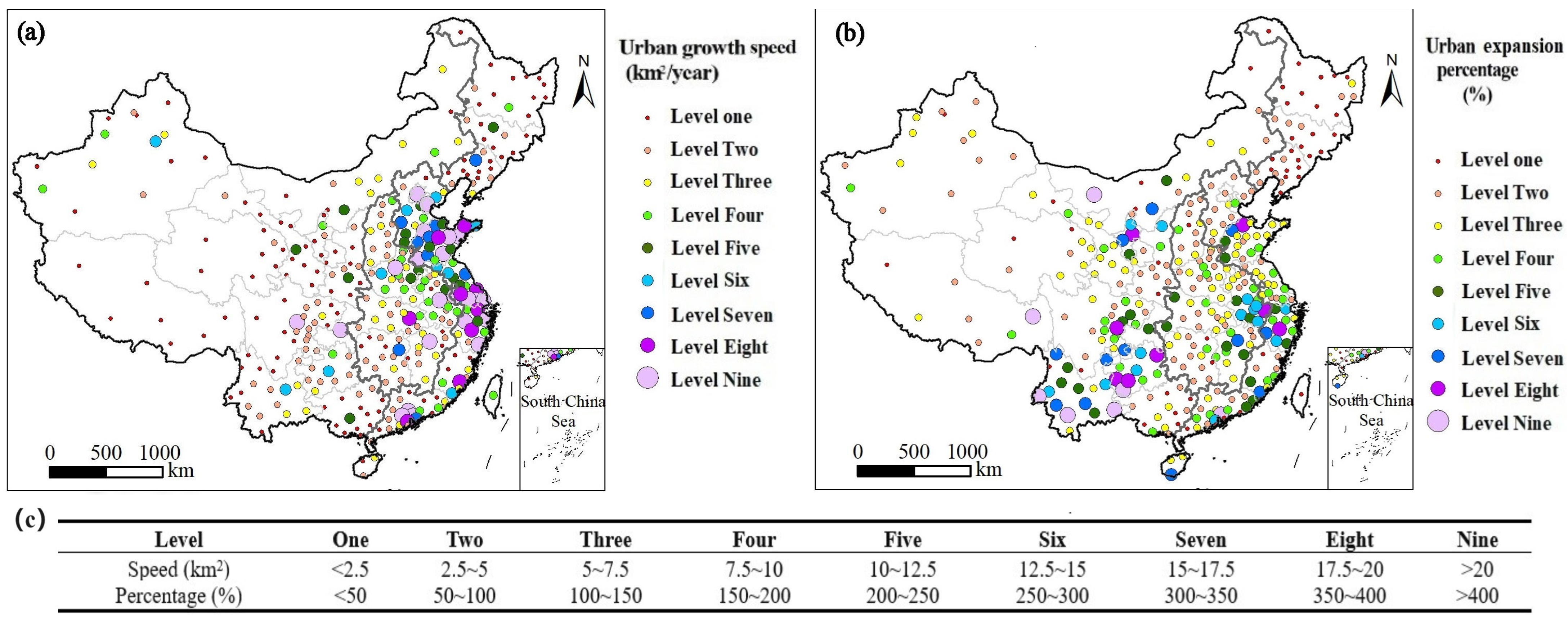
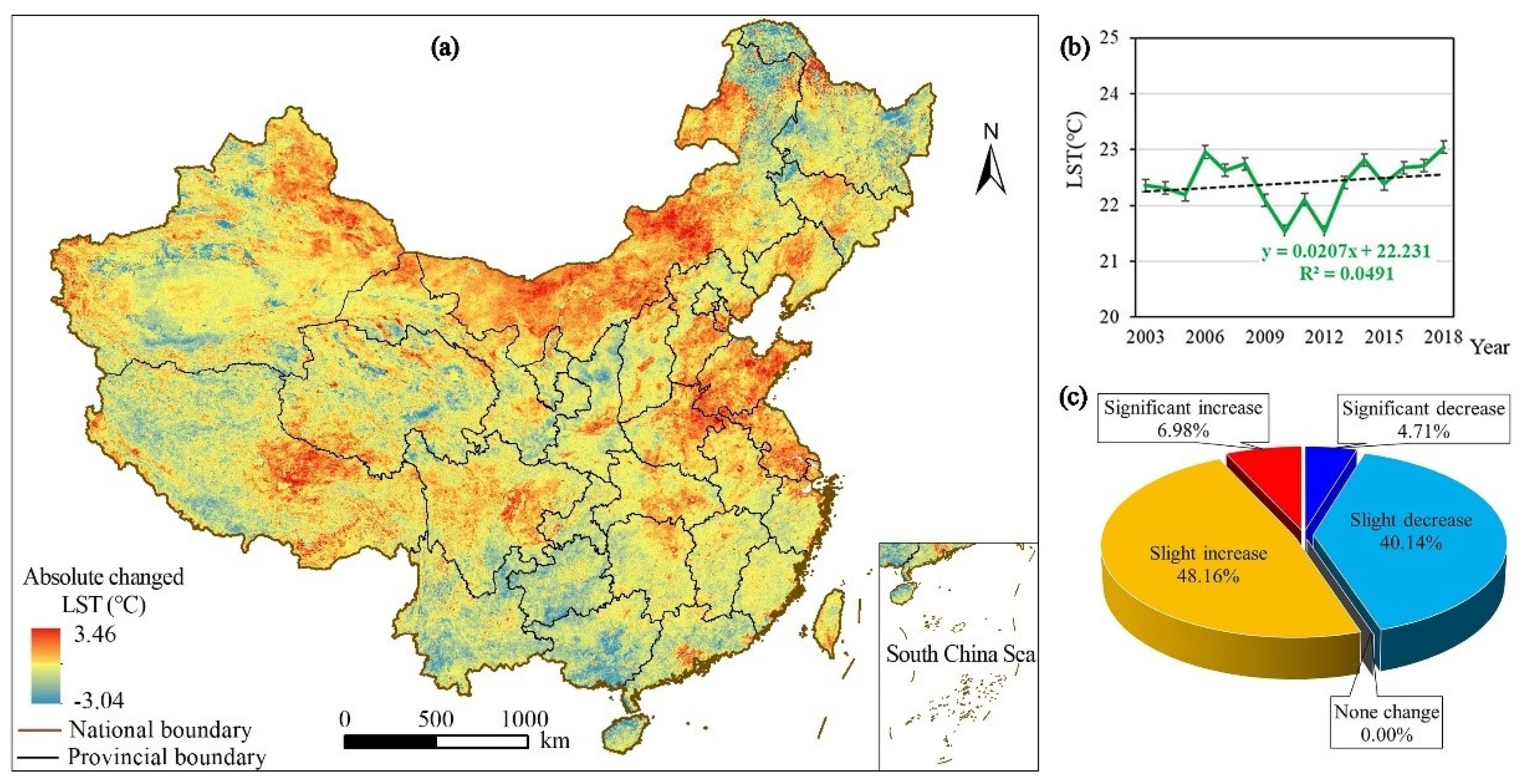



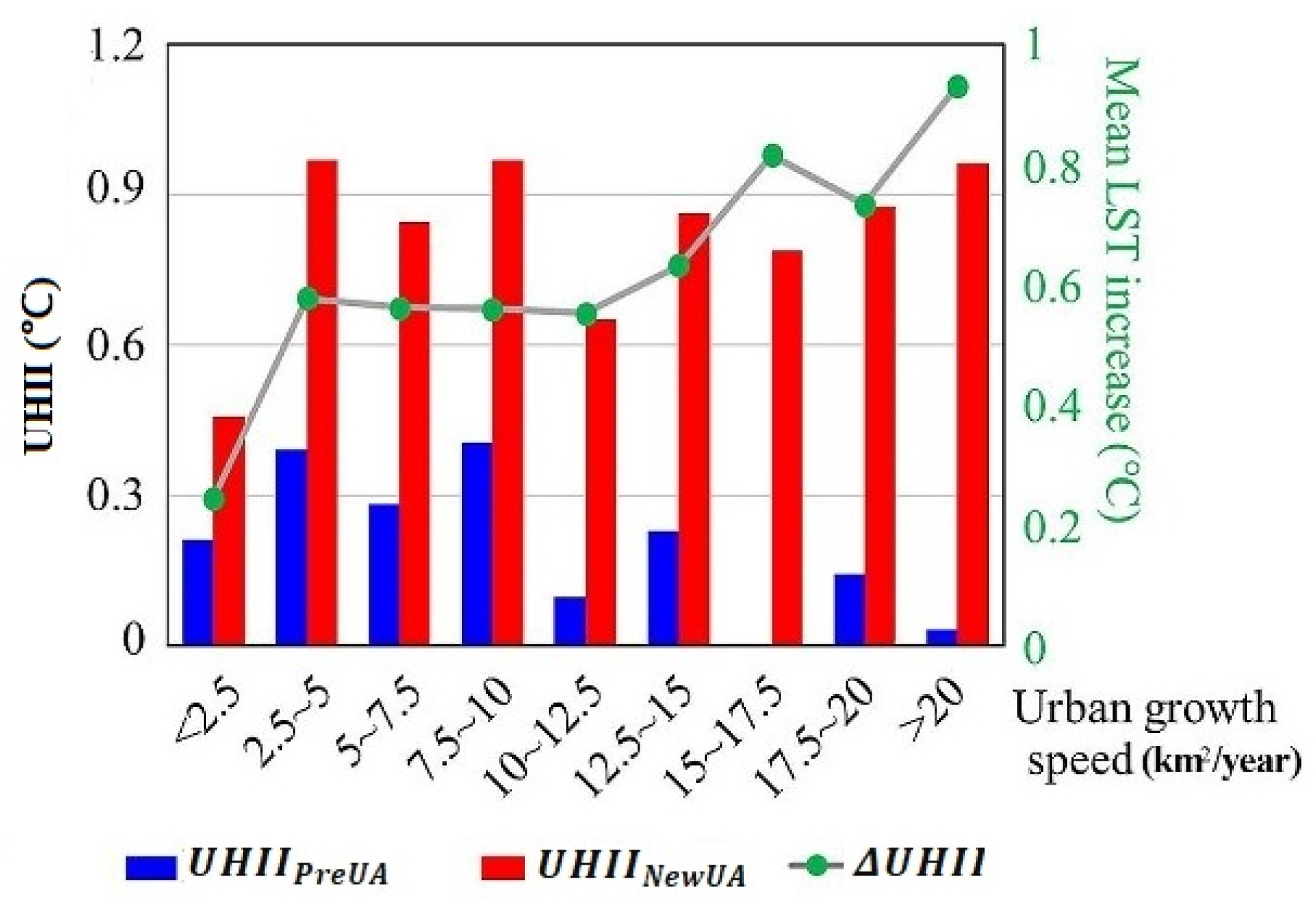
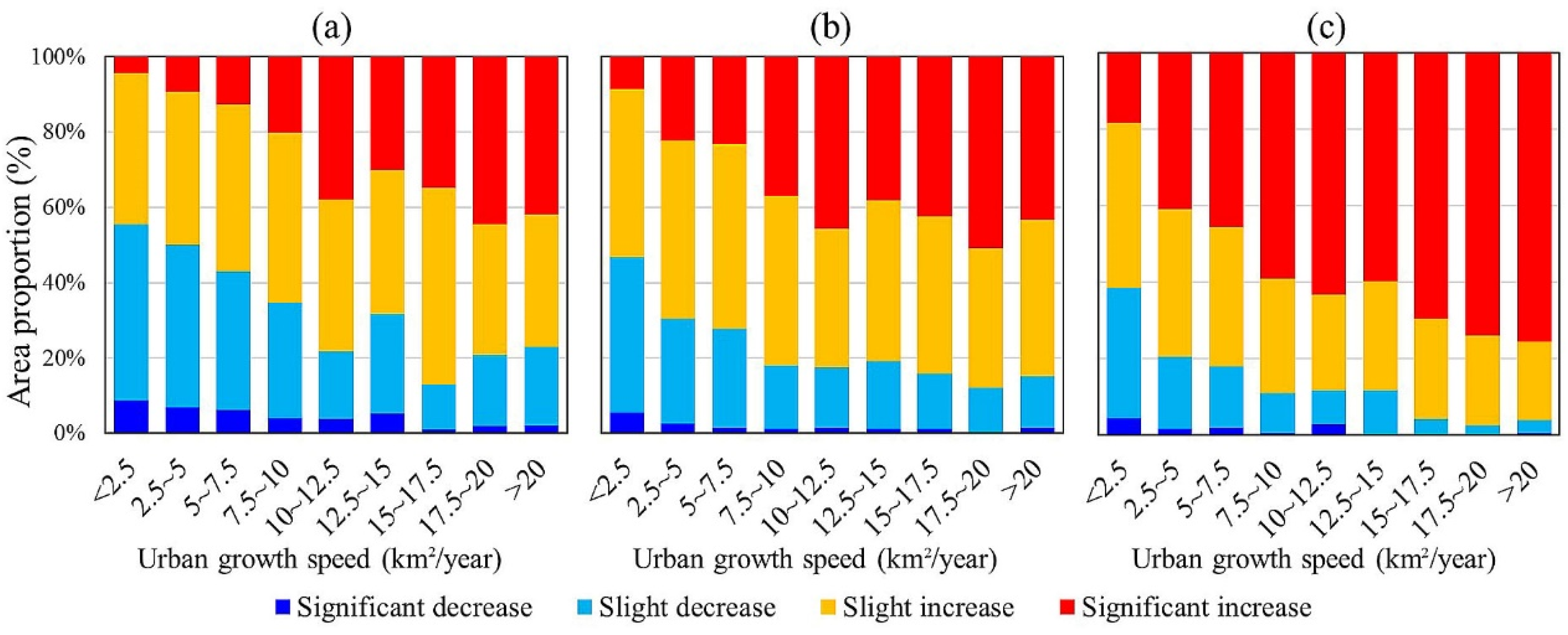
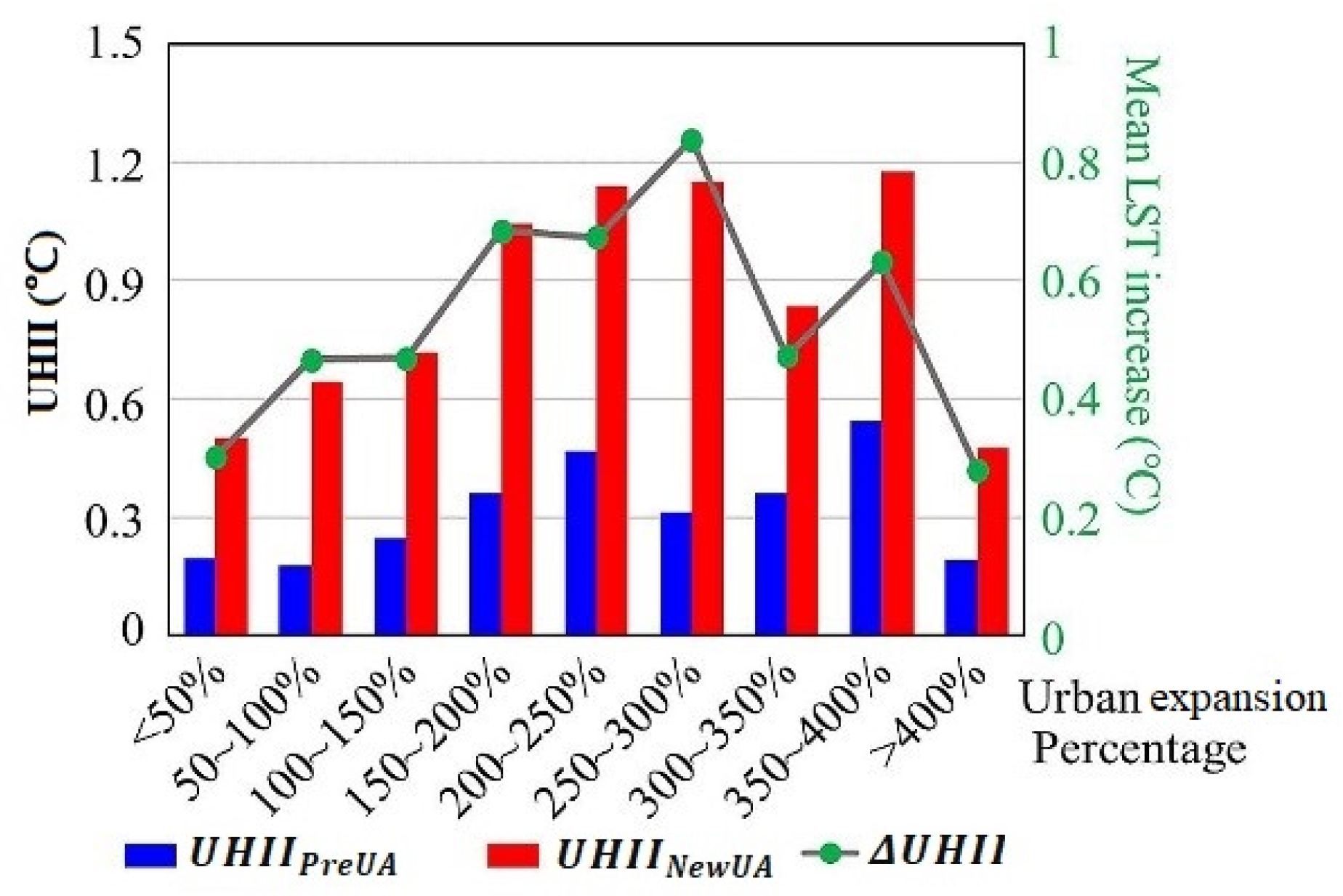

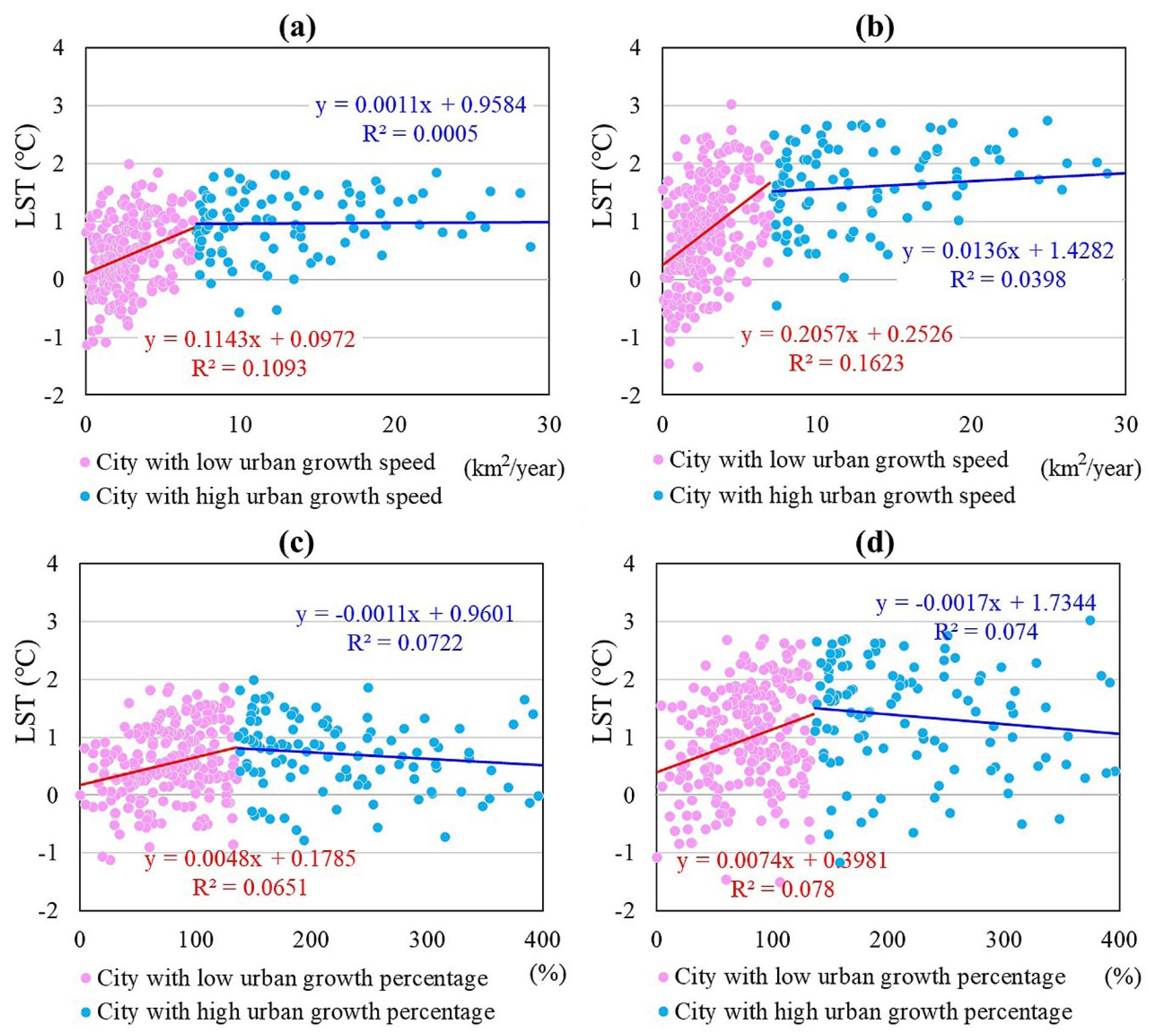
| Product | MYD11A2 | NLUD-C |
|---|---|---|
| Band | LST_Day_1 km | Land use/cover |
| Time resolution | 8 days | 5 years |
| Spatial resolution | 1 km | ----- |
| Time period | 2003.01.01–2018.12.31 | 2000–2015 |
| Coverage scope | China | China |
| Urbanized Areas | Area Proportions of Decreasing Trend (%) | Area Proportions of Increasing Trend (%) | ||
|---|---|---|---|---|
| Significant | Slight | Significant | Slight | |
| Previous UA | 1.95 | 23.31 | 30.78 | 43.96 |
| New UA | 1.42 | 11.61 | 63.95 | 31.32 |
Disclaimer/Publisher’s Note: The statements, opinions and data contained in all publications are solely those of the individual author(s) and contributor(s) and not of MDPI and/or the editor(s). MDPI and/or the editor(s) disclaim responsibility for any injury to people or property resulting from any ideas, methods, instructions or products referred to in the content. |
© 2024 by the authors. Licensee MDPI, Basel, Switzerland. This article is an open access article distributed under the terms and conditions of the Creative Commons Attribution (CC BY) license (https://creativecommons.org/licenses/by/4.0/).
Share and Cite
Yu, S.; Zhu, Z.; Zhang, Z.; Cai, S.; Liu, F.; Zhao, X.; Wang, X.; Hu, S. Land Surface Temperature Changes in Different Urbanization Increments in China since 2000. Land 2024, 13, 417. https://doi.org/10.3390/land13040417
Yu S, Zhu Z, Zhang Z, Cai S, Liu F, Zhao X, Wang X, Hu S. Land Surface Temperature Changes in Different Urbanization Increments in China since 2000. Land. 2024; 13(4):417. https://doi.org/10.3390/land13040417
Chicago/Turabian StyleYu, Sisi, Zijuan Zhu, Zengxiang Zhang, Shangshu Cai, Fang Liu, Xiaoli Zhao, Xiao Wang, and Shunguang Hu. 2024. "Land Surface Temperature Changes in Different Urbanization Increments in China since 2000" Land 13, no. 4: 417. https://doi.org/10.3390/land13040417





